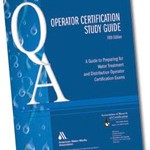For many water treatment operators, math is the most intimidating part of the water treatment exam. While there’s no magic solution that will instantly make all math problems a breeze, there are some things you can do to better prepare…
Blog Archives
Water Treatment Certification Exam

While the water treatment certification exam has become increasingly difficult as government regulations have become more stringent, the study guides simply have not kept pace.
The Class D water treatment certification exam administered by AMP (Applied Management Professionals) has a failure rate of over 50%. The Class A certification exam has a failure rate of over 90% each month.
If you are preparing to take the exam, these stats aren’t meant to scare you. This is to make you aware of the difficulty of the exam if you are not adequately prepared and to direct you to online resources on this and other websites that will help you be successful in passing the water treatment certification exam.
Coagulation

Coagulants Coagulants are defined as the substances which are capable of removing colloidal impurities from water. With this definition in mind, it is well to have some understanding of the nature of these colloidal impurities. Colloids Classification and Properties…
Preparing for the Water Treatment Exam

When I hear that someone is going to take a certification exam, I’m torn between offering sympathy or advice. Having taken many, many tests (the most recent being a professional engineering exam) and having done regulatory and math training for…
The removal of manganese, iron and ammonium nitrogen on impregnated activated carbon
[ad#Post Body] Product Description This digital document is a journal article from Desalination, published by Elsevier in 2007. The article is delivered in HTML format and is available in your Amazon.com Media Library immediately after purchase. You can view it…
Top 10 Water Treatment Certification Study Guides
[ad#Post Body] 1. Operator Basics 2005 Training Series – Created by the Montana Water System and Montana University, the Operator Basics Training Series is one of the most comprehensive study guides available. Not just another text document with page after page…
Wastewater Treatment Plant Operator
A wastewater treatment plant operator is responsible for purifying wastewater. Operators remove harmful chemicals, contaminants and solid waste from domestic and commercial wastewater. The treated water is then returned to the rivers and streams.
Wastewater Treatment Plant
A wastewater treatment plant removes contaminants from wastewater and sewage. The treatment process used physical, chemical and biological processes to removed contaminants. Once the wastewater treatment process is complete, a clean water stream and the solid waste is safe to…
Characteristics of Aquifers
Groundwater refers to water located beneath the surface in soil pore spaces and in fractures of rock (lithologic) formations. An aquifer is an underground layer of water bearing, permeable rock or unconsolidated materials such as gravel, sand, silt, or clay.…
Complete Water Treatment Operators Online Study Guide
Preparing for the water treatment operator’s exam can seem overwhelming. Study material is scattered throughout various publications. The goal of this website is to compile a complete and comprehensive resource to help those preparing to take the water treatment operator…
